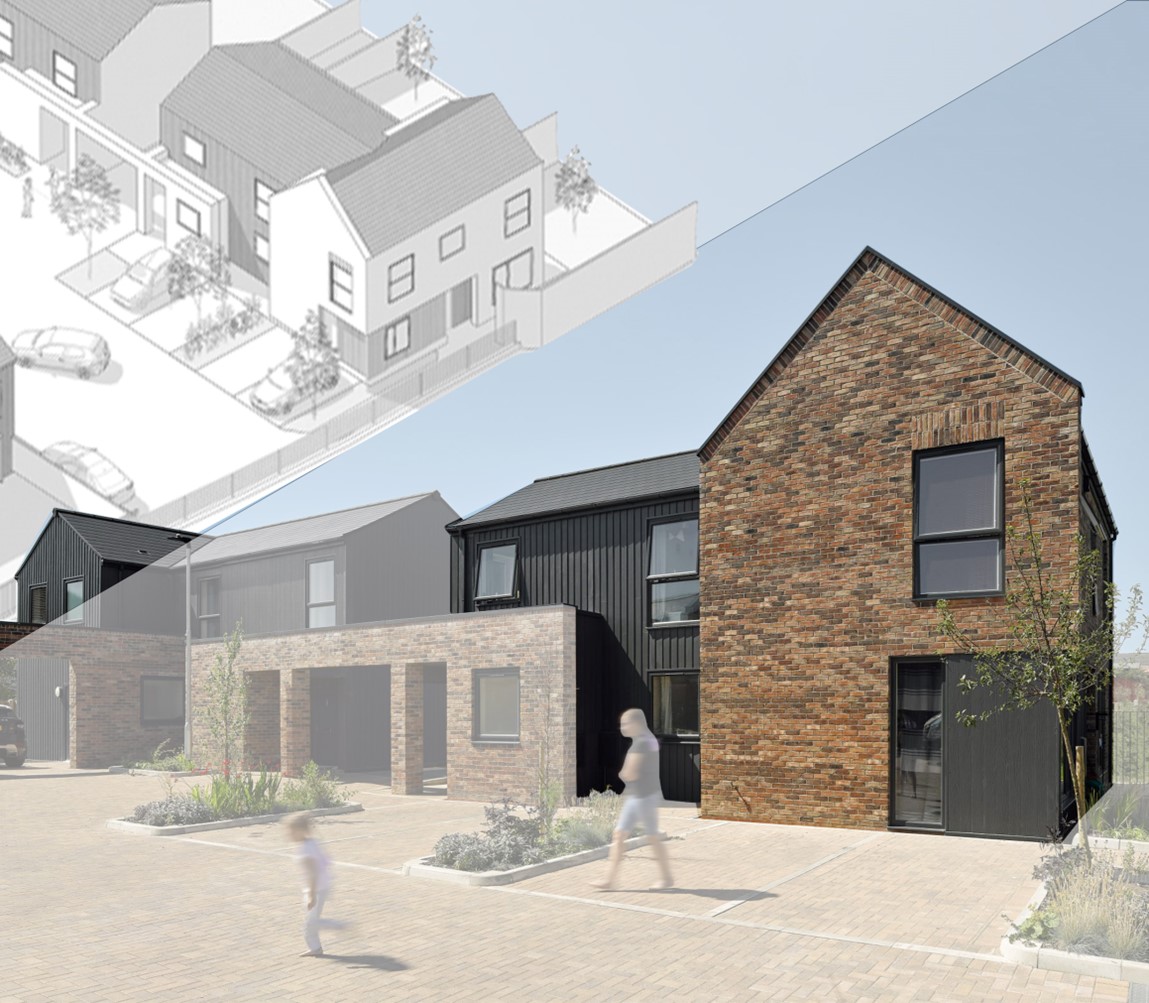A Transdisciplinary Peek Behind Secondment Scenes & Common Challenges to Housing Associations in England
Posted on 22-10-2023
Written by Aya Elghandour
Reviewed by Natalie Newman
The Housing Crisis, Cost of Living Crisis, and Climate Change Crisis are undoubtedly critical concerns of the general public. The three crises are interrelated. Please take a moment and think, how many disciplines are involved in those crises? Do you think investigating solutions by first understanding the complexity of any housing-related crisis, can stem from a mono-lens? Needless to say, end-users rights might get lost in ongoing debates. For instance: Hello! Do you see as critical in this debate the future of residents' health and wellbeing living in affordable housing properties?
That is why I joined the South Yorkshire Housing Association (SYHA) for a secondment!
Transdisciplinarity in research has been widely recommended to tackle complex situations influenced by various stakeholders. It is all about mutual learning and exchanging knowledge between disciplines and actors to understand complex issues and produce new knowledge comprehensively.
This is what I have been doing for the last three months in the South Yorkshire Housing Association (SYHA) while joining the Development and Asset Management team! As an architect-researcher and prior to joining SYHA, my perception was limited to housing associations and architects as key decision-makers whose decisions have the greatest impact on the house quality and as a result the health and wellbeing of future residents. However, being at SYHA's headquarters expanded my horizons and gave me new perspectives on the various factors and stakeholders influencing those decisions. This broader perspective now guides my current research.
Behind the Scenes of how did it all start!
Six years ago, Miranda Plowden SYHA's Business Development Director planted the seed for my research project in collaboration with my supervisor, Professor Karim Hadjri. She emphasized that Life Cycle Costing (LCC) should be one of the critical pillars guiding SYHA's partnership with RE-DWELL. That's why I have spent three months in SYHA to understand their workflow, decision-making process, who are the key stakeholders in the design stages and what initial costs of construction and future costs of maintenance they are responsible for.
During the secondment, I conducted two learning sessions to initiate discussions with the team and gauge their receptiveness to adopting new approaches in constructing and operating houses over their life cycle that could contribute to residents' health and wellbeing. For instance, using sustainable materials with thermal and acoustic insulation properties in construction. Additionally, I showcased an example from the British Council of Dudley, where Internet of Things (IoT) devices were installed in council houses to monitor indoor temperature, humidity, and air quality for residents' awareness. The team shared past incidents where residents had turned off similar devices due to concerns about their lighting. These discussions proved to be highly informative and shed light on aspects that I had not previously considered in my research.
Scene of Life Cycle Costing in SYHA
Life Cycle Cost (LCC) is all about estimating the costs of something over its entire lifespan. For SYHA, their commitment and ambition to LCC covers the entire life of a house.
Currently, SYHA's LCC approach gives a high-level overview, making initial assumptions about construction and future repair costs before seeking planning permissions for housing projects. However, it hasn't fully integrated expenses like estimated energy and water bills that future residents will incur, which is a common practice in existing literature.
My research aims to develop an LCC framework that prioritizes the health and financial wellbeing of households during the design stages of new houses. SYHA's involvement spans from architects' procurement, land selection, and design briefs to evaluating design proposals, obtaining planning permissions, hiring contractors, overseeing construction for quality assurance, and finally, renting out the house or selling it for shared ownership. They also manage and maintain the properties while learning from past challenges to make better future decisions.
SYHA is open to innovative approaches, such as constructing two homes using Modern Methods of Construction (MMC) like the WikiHouse project. This helps them assess whether these methods can reduce construction time, lower maintenance costs, and deliver better quality for end-users.
While the use of LCC isn't common in affordable housing provision, it's a top priority for SYHA. They rely on LCC to understand the long-term financial implications of their decisions.
The Sneak peek on common challenges of housing associations
From day one and from SYHA's reputation, their care for residents' health and wellbeing can be seen in their adoption to people-first approach. The approach is adopted in designing their housing schemes to provide a beautiful, safe, and affordable place to call home. This approach leads to some challenges for housing associations in England to keep high standards with lower than market rent.
My secondment observations and discussions, as well as the ongoing interview conversations revealed some of the challenges facing the provision of an affordable and healthy house, for instance:
- The emergence of technologies without the existence of a reliable supply chain for long-term house maintenance. For instance, with SYHA's 50-year presence in the British market, they prioritize relying on trustworthy providers who can ensure the longevity of house maintenance. If a new technology is considered sustainable and beneficial for residents but is not widely adopted in the UK or lacks a reliable provider for long-term support, the adoption process becomes a complex decision as every penny carries a responsibility.
- The continuous rise in construction costs after they have secured funding, for a certain price to deliver a certain quality. This hinders them from accomplishing the full quality they are aiming for.
- The fact that housing associations' rent is lower than the market price poses future financial risks and stress on affordable housing providers. Let's see SYHA's initial feasibility study for a new housing scheme that aims to offer units with affordable rent. The process involves several key steps:
Step 1. Identify what type of housing to build and its specific location.
Step 2. Research and determine the average market price for similar properties in this location.
Step 3. Set the affordable rent at 80% of the market rent.
Step 4. Assess the affordable rent by asking: Would it exceed 33% of the household income?
Step 5. As an ethical provider, If the rent exceeds the 33% threshold, a decision has to be made either to reduce the rent, or not prioritize homes in that location and reconsider the whole project or recognize that a higher rent is the only way these type of homes would be built in a given location.
Housing associations need a certain level of rent to be able to build good homes in the first place and to maintain them to a high standard. In the context of affordable rents, it becomes more challenging to balance. They need to set rents at a level that allows them to construct and maintain quality homes while keeping them affordable for residents over time. This involves choosing suitable locations and constructing quality housing, which already can lead to higher land and construction expenses. Moreover, affordable rents make it take longer for housing associations to recover their construction costs through rental income, especially when compared to the private sector!
Housing associations are currently the primary providers of affordable homes in England! So, it can be seen that the quality, sustainability, energy-efficiency, and location of an affordable house is so far up to housing providers decisions and the robustness of the national building regulations and support!
So what support housing associations need to provide more affordable houses that is healthy, sustainable, and energy-efficient on the long-term? Land price discount maybe to start with? What else would you add to the list?
Some awesome links!
https://www.wikihouse.cc/featured-projects/south-yorkshire-housing-association
https://ashden.org/news/social-housing-is-key-to-climate-action/
Miranda Plowden's Blog on the Wikihouse: https://www.mirandaplowden.com/projects/wikihouse-sheffield-2018-could-offsite-construction-be-the-solution-to-the-uks-housing-crisis
Related cases

North Wingfield Road social housing complex.
Created on 25-11-2022




